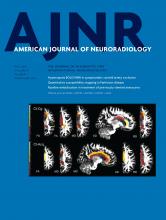Index by author
Jabbour, P.
- FELLOWS' JOURNAL CLUBNeurointerventionYou have accessPipeline Embolization Device in the Treatment of Recurrent Previously Stented Cerebral AneurysmsB. Daou, R.M. Starke, N. Chalouhi, S. Tjoumakaris, D. Hasan, J. Khoury, R.H. Rosenwasser and P. JabbourAmerican Journal of Neuroradiology May 2016, 37 (5) 849-855; DOI: https://doi.org/10.3174/ajnr.A4613
Twenty-one patients with previously stented recurrent aneurysms who later underwent Pipeline Embolization Device placement (group 1) were retrospectively identified and compared with 63 patients who had treatment with the Pipeline with no prior stent placement (group 2). Pipeline treatment resulted in complete aneurysm occlusion in 55.6% of patients in group 1 versus 80.4% of patients in group 2. The retreatment rate in group 1 was 11.1% versus 7.1% in group 2. The authors conclude that the Pipeline is less effective in the management of previously stented aneurysms than when used in nonstented aneurysms.
Jackson, A.
- EDITOR'S CHOICEADULT BRAINOpen AccessMitotic Activity in Glioblastoma Correlates with Estimated Extravascular Extracellular Space Derived from Dynamic Contrast-Enhanced MR ImagingS.J. Mills, D. du Plessis, P. Pal, G. Thompson, G. Buonacorrsi, C. Soh, G.J.M. Parker and A. JacksonAmerican Journal of Neuroradiology May 2016, 37 (5) 811-817; DOI: https://doi.org/10.3174/ajnr.A4623
Twenty-eight patients with newly presenting glioblastoma multiforme underwent preoperative conventional imaging and T1 dynamic contrast-enhanced MRI. Parametric maps of the initial area under the contrast agent concentration curve, contrast transfer coefficient, estimate of volume of the extravascular extracellular space, and estimate of blood plasma volume were generated, and the enhancing fraction was calculated. High values of the estimate of volume of the extravascular extracellular space were associated with a fibrillary histologic pattern and increased mitotic activity. This finding is counterintuitive to the standard concept that more proliferative tumors would be more densely packed with cells and have less extracellular space. As the authors point out, this surprising finding requires more investigation to understand whether this relationship will hold, and what the underlying mechanism might be.
Jahan, R.
- NeurointerventionYou have accessTICI and Age: What's the Score?L.A. Slater, J.M. Coutinho, J. Gralla, R.G. Nogueira, A. Bonafé, A. Dávalos, R. Jahan, E. Levy, B.J. Baxter, J.L. Saver and V.M. Pereira for the STAR and SWIFT investigatorsAmerican Journal of Neuroradiology May 2016, 37 (5) 838-843; DOI: https://doi.org/10.3174/ajnr.A4618
Jallo, G.I.
- Pediatric NeuroimagingOpen AccessCerebral Reorganization after Hemispherectomy: A DTI StudyA. Meoded, A.V. Faria, A.L. Hartman, G.I. Jallo, S. Mori, M.V. Johnston, T.A.G.M. Huisman and A. PorettiAmerican Journal of Neuroradiology May 2016, 37 (5) 924-931; DOI: https://doi.org/10.3174/ajnr.A4647
Jamali, S.
- NeurointerventionYou have accessInter- and Intrarater Agreement on the Outcome of Endovascular Treatment of Aneurysms Using MRAS. Jamali, R. Fahed, J.-C. Gentric, L. Letourneau-Guillon, H. Raoult, F. Bing, L. Estrade, T.N. Nguyen, É. Tollard, J.-C. Ferre, D. Iancu, O. Naggara, M. Chagnon, A. Weill, D. Roy, A.J. Fox, D.F. Kallmes and J. RaymondAmerican Journal of Neuroradiology May 2016, 37 (5) 879-884; DOI: https://doi.org/10.3174/ajnr.A4609
Johnston, M.V.
- Pediatric NeuroimagingOpen AccessCerebral Reorganization after Hemispherectomy: A DTI StudyA. Meoded, A.V. Faria, A.L. Hartman, G.I. Jallo, S. Mori, M.V. Johnston, T.A.G.M. Huisman and A. PorettiAmerican Journal of Neuroradiology May 2016, 37 (5) 924-931; DOI: https://doi.org/10.3174/ajnr.A4647
Jones, C.K.
- ADULT BRAINOpen AccessQuantitative Susceptibility Mapping Suggests Altered Brain Iron in Premanifest Huntington DiseaseJ.M.G. van Bergen, J. Hua, P.G. Unschuld, I.A.L. Lim, C.K. Jones, R.L. Margolis, C.A. Ross, P.C.M. van Zijl and X. LiAmerican Journal of Neuroradiology May 2016, 37 (5) 789-796; DOI: https://doi.org/10.3174/ajnr.A4617
Jost, T.
- NeurointerventionOpen AccessEndovascular Cooling Catheter for Selective Brain Hypothermia: An Animal Feasibility Study of Cooling PerformanceG. Cattaneo, M. Schumacher, C. Maurer, J. Wolfertz, T. Jost, M. Büchert, A. Keuler, L. Boos, M.J. Shah, K. Foerster, W.-D. Niesen, G. Ihorst, H. Urbach and S. MeckelAmerican Journal of Neuroradiology May 2016, 37 (5) 885-891; DOI: https://doi.org/10.3174/ajnr.A4625








